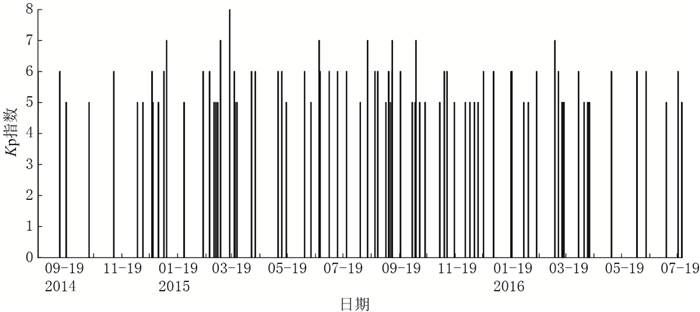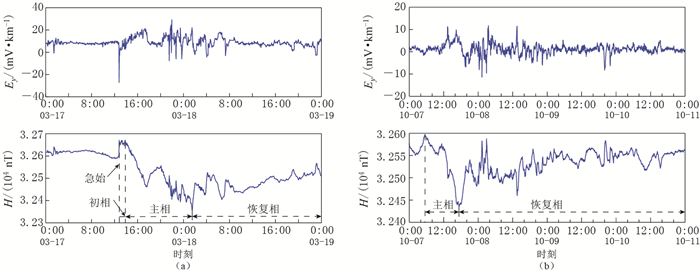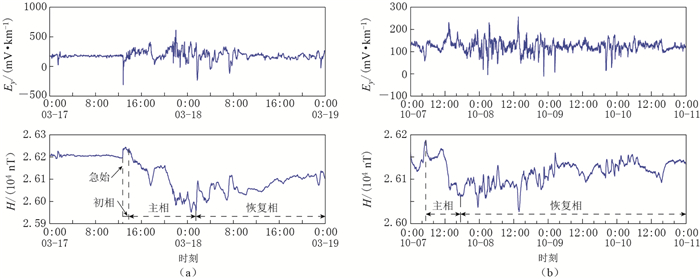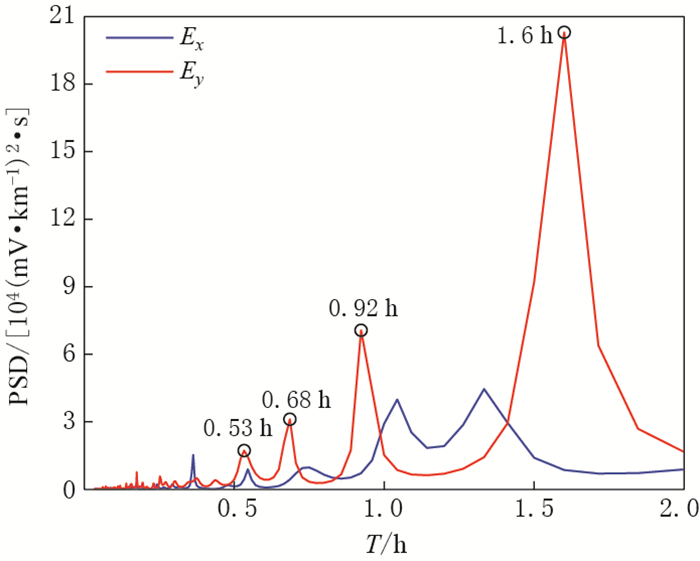The time-frequency characteristics of geoelectric storm in Chinese mainland
-
摘要: 基于沿中国大陆两条经度链(118°E,99°E)、两条纬度链(40°N,34°N)的25个台站地电场分钟测量数据,分析了2014年8月至2016年8月共83次地电暴(磁情指数Kp≥5) 的波形特点,认为:地电暴可分为急始型、缓始型两类,一般持续1—3天;地电暴在广大区域同时发生,变化波形相同或相似,表现为明显的广域性特点.讨论了地电暴对地磁暴的变化响应以及不同台站和测道之间地电暴变幅的差异,认为地磁暴期间太阳风等引起的空间电磁场变化与地球介质相互作用激发大地电流产生变化,引起了地电场快变化和地磁场快变化的强烈响应,且地电暴变幅与台址地下介质电导率关系密切,电导率越小,变幅越大.用最大熵谱方法估算了地电暴的主要周期成分,按功率谱密度大小依次约为1.6 h,1 h,15 min,10 min等,而且不同地电暴的优势周期略有不同.Abstract: A total of 83 geoelectric storms (GESs) of Kp≥5 during the period of August of 2014 to August of 2016 are exhaustively analyzed by using the waveform analysis and maximum entropy estimation methods based on the minute-values of geoelectric field from 25 stations along two longitude chains (118°E and 99°E) and two latitude chains (40°N and 34°N) in Chinese mainland, and then the time-frequency variation characteristics of the geoelectric storm (GES) are studied in detail. As a result, the following understandings are obtained: there are two types of GESs, i.e., sudden commencement GES and gradual commencement GES, and they usually continue for one to three days; GESs synchronously occur in a wide area with the same or similar waveforms, suggesting a wide-area characteristic of GES. The response of the GES to the variation of the geomagnetic storm is discussed, and the differences in amplitude variation between different stations and in different directions are also discussed. It is believed that the interaction between the space electromagnetic field caused by the solar wind during the geomagnetic storm and the interaction of the Earth's medium causes a change in the ground current, which results in a strong response to the rapid change in the geoelectric field and the rapid change in the geomagnetic field. The amplitude of GES is related to the underground medium conductivity underneath the geoelectric field stations. The smaller the conductivity is, the lager the amplitude is. In general, the geoelectric storm principally has 1.6 h, 1 h, 15 min and 10 min periodic components according to the size of their power spectrum density, which have a little difference among different GESs.
-
引言
地电场变化主要包括地电日变化、地电暴(geoelectric storm)、地电微变化等快变化成分和慢变化的自然电场.固定台网的地电场观测对地球电磁场变化研究以及地震火山等灾害事件的监测预报具有重要意义(克拉耶夫,1951;孙正江,王华俊,1984;傅承义等,1985;李金铭,2005;黄清华,刘涛,2006;李宁等,2007;马钦忠,2008;范莹莹等,2010;刘君等,2011;马钦忠等,2014;章鑫等, 2016, 2017a).地电暴是地磁暴(geomagnetic storm)发生期间地电场观测中所记录到的电扰变化,是变化最为剧烈的地电场变化成分;地电暴和地磁暴起因于相同的场源,其在大地构造、活动构造监测、生命线工程防损、无线电通讯通信等领域的应用和研究具有广阔的应用前景(郑宽等,2013;刘连光,吴伟丽,2014;章鑫等, 2017a, b).目前,关于磁暴的研究成果较丰富,而且仍在不断地探索(Gosling et al,1991;杨少峰等,2002;徐文耀,2003;王建军等,2017),但关于地电暴的研究尚远不及对磁暴的研究深入.其次,地电暴和地电日变化是目前地电场观测中出现最为普遍且最易识别的两个变化成分,其中关于地电日变化的研究已取得了很有意义的进展,关于地电暴的研究及其变化特征的认识亟需推进(孙正江,王华俊,1984;叶青,2006;张学民等,2006;杜学彬等,2007a;郭建芳等,2010;崔腾发等,2013;胡小静,付虹,2013;谭大诚等,2014;王丽等,2015).由于地电场变化与台址电导率关系密切,且易受介质孔隙度、导电流体以及气象等因素的影响,所以地电暴变化所受到的影响因素较地磁暴多,但目前的研究很少涉及这些影响因素.
我国自“九五”后期开始,固定台网的数字化地电场观测技术取得了长足进展,目前已建成了全球最大规模的定点、连续、规范化观测的地电场台网,截至目前全国运行观测123个台站,积累了丰富的基础观测数据.本文拟选取我国地电台网中沿两条经度链(118°E,99°E)和两条纬度链(40°N,34°N)的地电场台站观测数据,将台址电导率等影响因素与地电暴时频域的广域性、区域性和局部性特征相联系,进一步研究地电暴的时频变化特征.
1. 台站及数据
考虑到地电场变化易受地下介质和大气温湿度等因素的影响,文中选取南北两条纬度链、东西两条经度链上的台站:沿118°E经线选取8个台站组成经度链a,由南向北依次为泉州、海安、高邮、郯城、陵阳、无棣、静海、昌黎台;沿99°E经线选取10个台站组成了经度链b,由南向北依次为腾冲、洱源、泸沽湖、甘孜、大武、都兰、武威、山丹、石嘴山、高台台;沿40°N纬线选取8个台站组成纬度链c,从西至东依次为乌什、高台、石嘴山、代县、大同、阳原、静海、昌黎台;沿34°N纬线选取8个台站组成纬度链d,从西至东依次为和田、都兰、大武、乾陵、合阳、郯城、高邮、海安台(图 1).地电暴与磁暴同源,选用上述台站同场地或毗邻的地磁场台站的观测数据.
数据时段选取为2014年8月至2016年8月磁情指数Kp≥5的地电暴、地磁暴测量数据,其中Kp指数来源于国家空间天气监测预警中心(2016). 图 2给出了本文将要分析处理的83次地电暴发生时段的Kp指数.
![]() 图 2 文中讨论的83次地电暴发生时段的Kp(≥5) 指数(引自国家空间天气监测预警中心, 2016)Figure 2. The Kp(≥5) indices of the 83 geoelectric storms discussed in this paper (after National Center for Space Weather, 2016)
图 2 文中讨论的83次地电暴发生时段的Kp(≥5) 指数(引自国家空间天气监测预警中心, 2016)Figure 2. The Kp(≥5) indices of the 83 geoelectric storms discussed in this paper (after National Center for Space Weather, 2016)2. 数据处理
地电暴数据处理采用时间域波形分析和频率域周期分析方法.其中,地电暴在时间域的波形分析采用沿经度链(图 1链a和链b)、纬度链(图 1链c和链d)各台站同测向长极距测道观测数据的对比分析,频率域分析则分别采用快速傅里叶变换方法和最大熵谱密度估计方法.
傅里叶变换的实质是:把波形分解为若干周期的正弦波,若这些波可以叠加成原来的波形,则被分解的若干周期子波即为原波形的傅里叶变换.快速傅里叶变换是离散傅里叶变换的快速算法,是估算一段观测数据中周期成分的常用方法,计算速度快,但要求数据长度N=2n(n为正整数)(程佩青,2007),同时满足N≫T(T为拟分辨的周期成分的周期)才能解析出谱成分. 崔腾发等(2013)使用快速傅里叶变换方法分析了地电日变化的周期(T)成分,数据长度N选取为10T以上(即N≥10T),获得主要周期成分的振幅由大到小依次为12.4/12 h,8 h,24 h等,其中12.4 h和12 h的周期成分恰好是主太阴半日潮M2波和主太阳半日潮S2波的周期成分.快速傅里叶变换方法的计算,是对无限长数据截断得到有限长度N的数据时间序列,并要求N=2n.其次,快速傅里叶变换方法对低抽样率时间序列数据的截断效应,易导致频域内的混叠效应和频谱泄漏,进而造成假频和低频谱分辨力,短时间序列的频谱分辨力更低(丁裕国,江志红,1998;聂士忠,王玉泰,2005).另一方面,地电场观测每天产出1440个分钟数据,地电暴并不像Sq变化那样每日出现,而是持续1—3天的短时程(N)、不重复的瞬态变化,难以满足快速傅里叶变换方法中地电暴数据长度N=2n的要求.
最大熵谱方法是20世纪60年代末发展起来的一种谱分析方法.熵是信息量大小的量度,在随机过程中可用来衡量一个过程随机性的强弱,随机性越强的序列,其谱熵也越大.最大熵谱方法分析的基本思想是对所测量的有限数据以外的数据不作任何假设,而是在信息熵为最大的前提下寻找满足约束条件的自相关函数与功率谱密度(power spectral density, 简写为PSD)的关系,用迭代法由已知数据信息预测未知延迟离散时间上的相关函数(韩大宇,1987).理论分析和实验结果(韩大宇,1987;宋治平等,1997)表明,用该方法可得到分辨率较高且平滑的PSD估计值曲线,特别是在时间序列较短时仍可得到较传统方法更为符合实际的频谱密度估计值. 宋治平等(1997)的研究显示,对于较短的数据序列,当模型阶数M不超过数据长度的一半时,谱估计稳定,且既能消除谱线分裂又能提高谱估计的分辨率. 崔腾发等(2013)使用快速傅里叶变换分析地电日变化中心周期成分,得到与叶青等(2007)和杜学彬等(2007a)用最大熵谱方法分析地电日变化的周期成分很吻合的结果,说明最大熵谱方法可用于分析地电场变化的频谱.
3. 地电暴时间域变化
3.1 地电暴波形
图 3a和图 4a分别为2015年3月17—18日急始型磁暴时江苏高邮、新疆乌什两台站(相距超过4500 km)的地电暴和地磁暴变化,图 3b和图 4b分别为2015年10月7—10日缓始型磁暴时两台站地电暴和地磁暴变化.对比两种类型的电暴、磁暴波形可知:① 3月17—18日急始型磁暴(也有相关专家认为这是两个磁暴的叠加,北京时间17日17时36分至20时08分为另一次磁暴的初相阶段)期间,17日12时47分地磁场H分量骤然变大,地电场东向分量Ey在12时47分骤然下降至最低值,后逐渐恢复,此时段为磁暴初相,电暴初相(含急始变化)对应磁暴初相;13时52分至次日01时30分(18日)为磁暴主相,电暴从13时52分到21时30分逐渐上升—下降,21时30分开始在电场基值附近上下大幅震荡;18日01时30分后随磁暴恢复相初期的短周期快变化成分增多电暴呈上下震荡,震荡幅度逐渐减小;18日10时21分开始随磁暴恢复相后期相对稳态地恢复变化,电暴震荡消失,恢复电场基值.与磁暴不同的是,在磁暴主相后期至恢复相初期时段(17日21时30分至18日10时21分),电暴剧烈震荡,并无磁暴那样完整的变化过程. ② 对于2015年10月7—10日缓始型磁暴,电暴持续时间较急始型电暴长,且看不到电暴初相;7日04时55分至17时22分为磁暴主相,期间从7日04时55分电暴逐渐上升,随后为磁暴恢复相,在恢复相初期电暴呈下降、上升变化,紧随其后至9日02时35分电暴呈大幅度的快变化震荡;之后的磁暴恢复相后期电暴震荡逐步消失,恢复至电场基值附近.此外,高邮、乌什两个远距离台站的电暴变化波形(包括震荡)相同且同步.
本文对25个台站2014年8月至2016年8月共计83个Kp≥5地电暴的变化波形进行了分析,得到地电暴大致可分为急始型和缓始型两类,其定义类似于磁暴.急始型电暴的初相在时间上与磁暴初相对应;在急始型磁暴主相初期阶段、缓始型磁暴主相至恢复相初期阶段,电暴均表现出上升—下降的变化波形,但不能按磁暴主相、恢复相时段明显区分出电暴主相与恢复相;紧随磁暴主相至恢复相初期电暴短暂的持续上升—下降变化波形之后,电暴表现为频繁震荡并逐渐减小直至恢复至基值附近;急始型电暴有明显对应磁暴的电暴初相(含急始变化),往往以电场骤然减小(增加)开始,在几分钟至几十分钟内出现脉冲变化并达到极值,一般约为10—150 mV/km,最大变幅可超过400 mV/km,之后开始恢复,持续几十分钟到几小时,且磁暴越大、台址地下介质电阻率越大,电暴变幅越大.缓始型电暴似乎无初相,在磁暴主相、恢复相期间与急始型电暴的变化类似,但持续天数可长达3—5天,与磁暴大小有关.另外,还有一类急始型地电暴,其初相、主相、恢复相变化很清晰,且与磁暴初相、主相和恢复相对应(叶青,2006),但其出现几率很低,此处不再赘述.
3.2 地电暴空间广域性
图 5给出了2015年6月23日磁暴日分别沿两条经链和两条纬链的台站Ey分量地电暴分钟值曲线(限于篇幅,仅图示了23个台站的Ey分量曲线,Ex分量变化与之类似).其中,分别沿经度链a和b的8个台(图 5a,b)中最北边台站与最南边台站的纬度差均大于14°, 分别沿纬度链c和d的8个台站(图 5c,d)中最东边台站与最西边台站的经度差接近或超过40°.由此来看,沿纬度链最大空间距离超过1500 km,沿经度链最大空间距离超过4000 km,但由图 5可见:① 在这样广大区域内地电暴是同时发生的,且各台站地电暴初相(尤其急始变化)的时间差不超过1分钟(含仪器时差);② 各台站地电暴曲线上的其它一些短暂持续的上升、下降变化与频繁震荡是同时发生的,且变化波形相同.显然,地电暴变化的同步性不同于地电日变化. 崔腾发等(2013)关于沿两条经度链、两条纬度链上的台站所记录到的地电日变化的研究结果表明,沿纬度链日变化的极值时间(即波峰、波谷的极值时间,这里借用“波峰”、“波谷”两个术语,实际上地电日变化起伏不是波动传播)有经度效应,即从东至西波峰或波谷的时差与各台站之间的时差相当吻合,且日变化主相的峰、谷极值时间集中在当地太阳时午前午后.
![]() 图 5 2015年6月23日沿经纬链各台站地电暴Ey分量曲线(a)经度链a;(b)经度链b;(c)纬度链c;(d)纬度链dFigure 5. The Ey-component curves of geoelectric storm recorded by the stations along the two longitude chains and two latitude chains on June 23, 2015(a) Longitude chain a; (b) Longitude chain b; (c) Latitude chain c; (d) Latitude chain d
图 5 2015年6月23日沿经纬链各台站地电暴Ey分量曲线(a)经度链a;(b)经度链b;(c)纬度链c;(d)纬度链dFigure 5. The Ey-component curves of geoelectric storm recorded by the stations along the two longitude chains and two latitude chains on June 23, 2015(a) Longitude chain a; (b) Longitude chain b; (c) Latitude chain c; (d) Latitude chain d在急始型电暴中,初相变化最显著(尤其急始变化),与磁暴初相急始时段相对应,但各台的电暴初相变幅却不同. 2015年6月23日地电暴发生时,沿118°E经度链(链a)的泉州台、海安台、高邮台、郯城台、陵阳台、无棣台、静海台、昌黎台的变幅分别达到227.17,44.04,96.16,33.86,456.47,40.17,70.708,75.623 mV/km.这8个台是按纬度从低到高的顺序所排列,单从变幅来看并无明显的纬度效应,这可能是由于变幅差异更多地与台址地下的介质相关,即不同场地对地电暴的变幅响应不同;同一台站Ex与Ey分量对同一地电暴的变幅也不尽相同.但是,从各台站地电暴时间、波形的变化特征来看,地电暴仍是大范围的同时性事件.另外,如图 6所示,2016年3月7日电暴发生时相邻两台站同方向长极距Ey变化的相关性明显高于2015年6月4日磁静日(所选数据中最为平静的一天).其次,对于沿各经纬链东、西、南、北远距离的昌黎与海安、昌黎与乌什、海安与和田台而言,其Ey分量的电暴日相关系数高于磁静日相关系数(图未示),这也说明电暴期间广大区域同时施加了强烈的电磁场.
4. 地电暴主要周期成分
由于地电暴变化中包括了太阳日变化、太阴日变化和太阳活动喷发的高速等离子粒子流与磁场相互作用所产生的长、短时程磁扰变化等,故在估算地电暴主要周期成分时采用暴时变化,尽可能避免静日变化的影响.与地磁场不同,地电场测量的基准值和变化幅值与台址电性结构极为相关,不同台站之间差异较大,所以估算地电暴周期成分时未剔除太阳日变化和太阴日变化等每天出现的周期成分.本文使用最大熵谱密度估计方法处理83次地电暴测量数据. 图 7a为2015年6月20日(磁静日)青海都兰台Ex和Ey分量的频谱曲线(即谱密度PSD曲线),图 7b为该台2015年6月23日磁暴(Kp=7) 时的地电暴频谱曲线.对比图 7a与图 7b可见:地电暴日的周期成分(图 7b)较磁静日周期成分(图 7a)丰富得多,说明磁暴时空间电磁活动所引起的短周期快变化成分十分丰富,且幅值变化剧烈;电暴日各频点的功率谱密度大于磁静日近1—3个数量级,这与叶青(2006)的地电暴功率谱密度估算结果相吻合;电暴日1.6 h—4 min周期成分的频谱很发育,约1.6 h为最优势周期,随着优势周期变短功率谱密度减小.另外,在频谱图中还出现了12 h,8 h等日变化长周期成分,文中暂不予讨论.
图 8给出了江苏海安台记录的2015年6月23日磁暴期间(同图 7b都兰台日期)的频谱曲线.海安台位于东部沿海地区,海拔约4 m,属于亚热带季风气候;都兰台位于青藏高原的高寒、干旱地区,海拔约3200 m,属于高原干旱大陆性气候.就是这两个布极区的气候环境、地形地貌、表层介质等完全不同的台站,地电暴时二者1.6 h—4 min内的周期成分却相同,不过电暴时海安台谱密度远小于都兰台的谱密度,特别是1.6 h周期成分,这说明台站的台址介质条件、大气环境等对地电暴变化的幅值有明显影响.
此外,分析2014年8月至2016年8月两年中83次地电暴的频谱还注意到:不同地电暴的优势周期略不同,谱密度值大小不同,且同一台站不同方向对同一次电暴还存在频散现象,例如图 8中海安台两个正交方向的优势周期成分表现出的频散差异. 表 1列出了2015年6月23日电暴时沿经度链a的各台站大于0.5 h的优势周期,可见:该次地电暴4 h以下频谱成分中1.6—1.3 h,1.17—0.8 h和0.91—0.54 h为主要周期成分,但同一台站Ex分量与Ey分量的优势周期大致相同却又不完全相同,即不同方向对地电暴时电磁场的响应不同.以1.6—1.3 h优势周期为例,泉州台、海安台、郯城台、无棣台、昌黎台两方向的优势周期相差约4,18,6,18,30 min,而高邮、陵阳、静海这3个台站无差别.其次,不同台站、同向分量的优势周期同样略有差别.取经度链a上各台站Ex分量的第一优势周期对比可知:泉州、高邮、静海、昌黎这4个台站的优势周期均为1.6 h,而郯城、陵阳两台站均为1.5 h,距高邮台很近的海安台为1.3 h,距静海台很近的无棣台为1.37 h,这说明对于同一地电暴,不同位置台站的优势周期略有差异.这种现象可能与不同台站的台址条件有关,如台址介质孔隙度、矿物成分及含量、水饱和度和水成分等,类似频散现象的机制.
表 1 2015年6月23日经度链a地电暴各台优势周期Table 1. Predominant period along the longitude chain a during the geoelectric storm on June 23, 2015台站 观测方向 优势周期/h 泉州 NS
EW1.60
1.540.97
0.940.68
0.69海安 NS
EW1.30
1.601.04
0.940.74
0.69高邮 NS
EW1.60
1.600.98
0.920.75
0.68郯城 NS
EW1.50
1.601.04
0.920.69
0.68陵阳 NS
EW1.50
1.501.00
0.900.70
0.69无棣 NS
EW1.37
1.601.00
1.170.73
0.80静海 NS
EW1.60
1.600.96
1.170.70
0.91昌黎 NS
EW1.60
1.101.00
0.080.71
0.545. 讨论与结论
5.1 地电暴对地磁暴的变化响应
对应地磁暴初相、急始变化以及后期的主相和恢复相,地电暴记录了急始变化、初相、主相以及短时上升—下降变化和短周期震荡等快变化,并与地磁场同时变化,表现出对地磁暴变化有强烈的电磁响应,且地电场快变化成分较地磁场变化更丰富.但是, 地电暴变化的波形并不像地磁场那样有完整的变化过程,在磁暴主相后期和恢复相阶段地电暴更多地表现为震荡、电脉冲丛集的现象,特别是在磁暴恢复相后期地电暴变化幅度小,且变化平稳.地电暴的这些变化特征可通过电磁场理论予以解释.
麦克斯韦(Maxwell)方程组和电磁性质方程完整地描述了介质电导率σ、电场E、磁场B等之间的相互关系,变化的电场产生变化的磁场,变化的磁场亦产生变化的电场.法拉第电磁感应定律

(1) 描述了当磁场变化时,会产生电场的空间变化,即感应电场的大小与磁场随时间的变化有关,磁场随时间的变化越快,电场变化越大.安培环路定律

(2) 描述了磁场空间变化是由位移电流随时间的变化和传导电流引起的,即感应磁场的大小与位移电流随时间的变化、传导电流有关,传导电流越强、位移电流随时间的变化越快,磁场的变化越大.式(1) 和(2) 揭示无论是磁场随时间的变化引起电场变化还是位移电流随时间的变化引起了磁场变化,均将电场变化与变化磁场清晰地联系起来.
文中应用了我国地电场、地磁场的分钟观测值数据,根据奈奎斯特定律可知,测量数据中最多包含了120 s以上的周期成分;其次,由图 7—8和表 1可知,地电暴周期成分主要为1.6,1 h左右和0.5 h以下.然而,在地球介质中,即使导电性最差的干燥岩石,电场变化的频率处于10—100 Hz时,电磁场仍以扩散为主.此时,传导电流的作用将远大于位移电流的作用,故后者可以忽略,也就是说,式(2) 中的∂D/∂t可忽略(傅承义等,1985),且电导率越大、频率越低,传导电流的作用越大.鉴于分钟值地电场、地磁场的测量数据中主要包含了低频的变化成分,此时电场与传导电流之间的关系可用欧姆定律

(3) 来确定.式中,J为电流密度,E为电场,σ为电导率.
综上所述,本文认为:在地磁暴期间太阳风等引起的空间电磁场变化与地球介质相互作用激发了大地电流的变化,从而引起了地电场快变化与地磁场快变化的强烈响应;然而,在主相后期和恢复相时段,电场变化波形并不像地磁场那样表现出完整的变化过程.
5.2 同一台站不同测向变幅差异现象
磁暴发生时,各地磁要素均发生剧烈变化,其中水平分量H接近地磁场北分量Hx方向变化最大,也最能代表磁暴整个过程的特点(徐文耀,2003).当地磁场Hx分量变化时,与其垂直方向的地电场也发生变化.我国地电场台站几乎全部为地表两个水平正交方向的观测(即Ex,Ey分量),与磁场Hx分量垂直的地电场分量为Ey分量,然而在所选取的25个台站中并不完全是地电场Ey分量的变幅大于Ex变幅,这主要是由于地下介质电性结构的差异所致.随着地球物理勘探对地震波和电磁波研究的深入,各向异性介质问题已经备受关注.一般地,地下介质是各向异性的,特别是地壳内岩(土)介质由于定向排列的导电物质颗粒、微裂隙等造成介质各向异性明显(Negi,Saraf,1989).其次,地下近地表的深部介质富含水.因此,用饱水的均匀方位各向异性介质近似上述介质,设微裂隙饱水,其电阻率为ρf,垂直微裂隙走向电阻率为ρ1,沿微裂隙走向电阻率为ρ2,介质骨架电阻率为ρ0(一般在含水情况下,ρ0≪ρf),裂隙率为ν(杜学彬等,2007b),并参考克拉耶夫(1951)的研究得到,垂直微裂隙走向(介质电性主轴x1)和沿微裂隙走向方向(介质电性主轴x2)的电阻率与ρ0,ρf,ν的本构关系为

(4) 据式(4) 导出, 当ν≪1时,各向异性系数λ与ρf, ρ0和ν的近似关系为(杜学彬等,2007b)

(5) 式中,λ>1,说明介质电性主轴x1方向的电阻率大于主轴x2方向的电阻率,即ρ1 > ρ2.当介质中导电物质颗粒定向排列时,ν表示颗粒所占体积的比率,ρf为颗粒电阻率,用方位各向异性介质描述同样可以得到式(5) 及其物理意义.
在各向异性介质中,式(3) 中的电导率σ为向量形式,式(3) 可改写为

(6) 式中,j为电流密度,E为电场,σ为电导率,下标1和2代表两个正交方向.由上式可看出:沿电性主轴x1和x2方向(即σ1,σ2方向),j1和j2仅与σ1和σ2有关,即j1=σ1E1,j2=σ2E2;沿其它方向,j1和j2与σ1,σ2以及σ12,σ21有关(石应骏等,1985).
由式(3)—(6) 可知:① 地电场强度及其变化幅值取决于介质电阻率(或电导率)的大小,电阻率越大(电导率越小),电场强度及其变化幅值越大;② 由于λ>1,即ρ1 > ρ2,沿两个电性主轴方向测量的地电场变化幅值不同,即地电场是向量分布的;③ 只要在一个时段内ρf,ρ0和ν不发生明显改变,沿两个电性主轴方向的地电场变化强度或幅值即可保持|E1| > |E2|或|E2| > |E1|.事实上,在地电场观测中还注意到,只要观测装置不变、测量电极不变,地表两个正交方向的电场强度及其变化幅值时常保持某个方向大、而另一正交方向小的现象. 叶青(2006)和杜学彬等(2007a)关于地电日变化的研究也表明,日变化幅值始终也保持这样的变化规律.这种两个正交方向的地电场差异被称为为地电场各向异性现象(傅承义等,1985).
基于地电场的向量分布和式(6),章鑫等(2016,2017a,b)应用滇、川、甘、青、宁、陕(南北地震带)、郯庐断裂带、大华北及附近的地电场测量数据,分别勾绘了3个区域的大地电流二维(平面)分布图像,其结果显示,在活动地块内地电流呈涡旋分布,主要活断层及其附近电流涡旋分异,流线收敛,表明大地电流涡旋分布与活动构造的关系极为密切.
5.3 不同台站同测向变幅差异现象
各台站对于同一地电暴所产生的地电场最大变幅不同,单从变幅大小来看纬度效应并不明显.本文选海安(01)、高邮(02)、郯城(03)、陵阳(04)、无棣(05)、静海(06)、昌黎(07)、阳原(08)、都兰(09)、武威(10)、乌什(11)、和田(12) 等12个台站来研究不同台站的地电暴最大变幅,绘制出相邻两台站Ey分量变幅的比值随时间变化的曲线,并添加趋势线,然后得到两台站一组6条拟合线:y01/02=0.008x+0.4596; y03/04=0.0007x+0.368; y05/06=0.0004x+0.4634; y07/08=0.0043x+0.8881; y09/10=-0.0011x+0.9486; y11/12=0.3794x+39.817.每条趋势线的倾斜角度均很小,两台站的比值也稳定在一定范围内(除y11/12外),这似乎说明地电暴变化幅值除了与磁场变化率有关外,还与地下介质的电阻率有关.用12个台站浅层电阻率值(半极距AB/2=5—10 m)计算相邻台站电阻率比值(表 2),可知12个台站中除了无棣台、静海台一组外,其余5组台站的浅表电阻率比值均与地电暴变幅比值对应,即视电阻率(极距小,可视为介质电阻率)大的台站,其变幅大于视电阻率小的台站.
表 2 12个台站浅表电阻率及其与邻台电阻率比值Table 2. Shallow resistivity of twelve stations and resistivity ratios of every two adjacent stations台站 地电阻率
/(Ω·m)电阻率比值 海安 14.50 0.75 高邮 19.40 郯城 15.51 0.13 陵阳 120 无棣 20.60 1.22 静海 16.85 昌黎 31.24 0.38 阳原 81.51 都兰 14.75 0.17 武威 89.11 乌什 346.29 2.26 和田 153.46 引入大地电磁测深波阻抗Zxy与Zyx的概念(石应骏等,1985),表征地电暴初相变幅与台站台址视电阻率的关系为

(7) 式中:ρ为介质视电阻率;Zyx为阻抗,Zyx=-Zxy;T为电磁场周期.在大地电磁中,一般首先计算Ey,Hx和Ex, Hy中周期T的波幅,然后由式(7) 得到周期为T的电磁场所对应的地下趋肤深度介质的视电阻率ρ.由于地电暴的主要周期成分很丰富(图 7,8),这里仅讨论地电暴变幅大小与视电阻率的关系.从原始曲线上估算同台观测的电暴(mV/km)、磁暴急始变化(nT)的幅值,粗略得到Z,这在物理意义上与大地电磁方法所计算得到的视电阻率是相同的.
选取乌什、无棣、陵阳、海安、高邮、昌黎和静海等7个电磁同场地台站的地磁暴、地电暴测量数据讨论台址介质电导率与地电暴变化幅值的相关性. 表 3列出了3次急始磁暴初相的波阻抗,其中2015年3月17—18日磁暴Kp=8,Dst指数最小值为-227 nT;2014年9月12—13日Kp=7,Dst指数最小值为-87 nT;2015年8月15—17日Kp=7,Dst指数最小值为-64.96 nT.
表 3 3次地电暴电磁同台的阻抗Z值Table 3. The impedance Z of several synthetic stations in three geoelectric storms台站 2015年3月17—18日 2014年9月12—13日 2015年8月15—17日 E
/(mV·km-1)B
/nTZ
/ΩE
/(mV·km-1)B
/nTZ
/ΩE
/(mV·km-1)B
/nTZ
/Ω乌什 499.32 46.1 10.83 423.76 67.3 6.30 147.15 38.5 3.82 无棣 53.2 13.86 3.84 3.59 81.3 0.04 0.24 40.0 0.006 陵阳 66.38 61.2 1.08 74.82 79.3 0.94 8.2 36.7 0.22 海安 15.22 72.2 0.21 10.31 92.9 0.11 2.99 44.4 0.07 高邮 31.37 56.6 0.55 36.04 89.1 0.40 15.04 44.1 0.34 昌黎 20.095 48.8 0.41 26.645 76.7 0.35 7.689 33.3 0.23 静海 18.103 51.2 0.35 27.300 80.0 0.34 11.683 43.0 0.27 由表 3可见,除了极个别台站,几乎全部都是波阻抗Z越大,地电场E的幅值越大.这个结果更确切地说明,台址介质的电阻率越大,地电暴变化幅值越大.事实上,关于地电日变化幅度的研究(叶青,2006;杜学彬等,2007a)也表明,总体上台址浅层电阻率越大,日变幅度也越大.
5.4 地电场不同测向的频散现象
文中使用地电场两个正交分量(Ex, Ey)的测量数据,由两个方向同时刻的地电场变化可矢量合成大地电流的流向(章鑫等, 2016, 2017a, b). 康国军等(1995)对自然、烘干状态,不同含水饱和度、矿化度,以及不同泥质含量、孔隙度等不同情况下的岩矿石样品进行1 kHz—1.1 GHz频段的频散实验,其结果显示,样品呈明显的频散现象:样品的介电常数ε和电导率σ均是频率f的复杂函数,介电常数ε随频率f升高而减小;在0.1—50 MHz频段,频散严重,随频率f增高频散减弱,而电导率σ随频率的升高而增大.此外,岩石孔隙度、含水量也是影响频率f的因素(康国军,佟文琪,1997).目前地电场台网观测是秒采样,然后产出电场的分钟平均值,地电暴的高频成分被“淹没”或随机体现在分钟值中,故容易出现脉冲等快变化.理论上由此时间序列数据只能分辨出2 min以上的周期成分,但所分辨的周期成分中仍包含着高频成分的影响.所以,尽管上述频散实验的频段高于可分辨的周期,但其实验结果对讨论地电暴频散现象仍有参考意义.我国地电台网中各台站场地条件有差异,一般两个正交方向与当地大地电流方向不一致,且在测道长度内地下介质成分、孔隙度、含水量均有差异,所以当地电暴发生时,在多种频率共同作用于地下介质的情况下,会导致两个方向地电场的特征频率既相同或相似但又不完全相同的频散现象.
5.5 结论
本文研究了25个地电场台站在两年间记录到的地电暴,得到的主要结论如下:
1) 地电暴一般持续1—3天,分为急始型和缓始型两类,但按磁暴主相、恢复相明确区分电暴主相、恢复相较困难;急始型磁暴主相初期、缓始型磁暴主相至恢复相初期,电暴均表现出持续上升—下降变化的特点,紧随其后为频繁的震荡,并逐渐减小直至恢复;急始型电暴的初相对应磁暴初相,一般以电场骤然减小(或增加)开始,在几分钟—数十分钟到达极值,多数急始变化约10—150 mV/km,然后恢复变化,且磁暴越大电暴变幅越大;缓始型电暴看不到初相,在磁暴主相、恢复相期间类似于急始型电暴的变化,有时持续3—5天.
2) 就目前的地电场分钟测量数据来说,地电暴在中国大陆广大区域内同时发生事件,且变化波形相同或相似,有明显的广域性特点;各台站地电暴显著相关,电暴期间相邻两台站地电场相关性高于无电暴时段的相关性.
3) 地电暴急始变化、上升—下降变化波形和震荡变化的幅度与地下介质电阻率关系密切,电阻率越大(电导率越小),其变幅越大,所以仅由变幅大小来看纬度效应不明显,不同台站以及相同台站的不同测向的变幅也不尽相同,表现出局部区域性的特点.
4) 地电暴周期丰富,就目前的分钟测量数据来说,周期成分主要集中在约2 h—4 min,其中约1.6 h,1 h,15 min,10 min等为主要周期成分,同时还存在周期成分的频散现象.
在以往的地电暴研究中,区域选择上往往局限在一个台站或者某个小区域内.本文尝试用大空间尺度、多台站数据研究地电暴时间域、频率域的广域性和局部性变化的特点,获得了一些新的认识,对地电暴变化特点的深入分析以及如何将广大区域的地电暴不同变幅量化为统一的指数,将是本研究的下一步工作.
-
图 2 文中讨论的83次地电暴发生时段的Kp(≥5) 指数(引自国家空间天气监测预警中心, 2016)
Figure 2. The Kp(≥5) indices of the 83 geoelectric storms discussed in this paper (after National Center for Space Weather, 2016)
图 5 2015年6月23日沿经纬链各台站地电暴Ey分量曲线
(a)经度链a;(b)经度链b;(c)纬度链c;(d)纬度链d
Figure 5. The Ey-component curves of geoelectric storm recorded by the stations along the two longitude chains and two latitude chains on June 23, 2015
(a) Longitude chain a; (b) Longitude chain b; (c) Latitude chain c; (d) Latitude chain d
表 1 2015年6月23日经度链a地电暴各台优势周期
Table 1 Predominant period along the longitude chain a during the geoelectric storm on June 23, 2015
台站 观测方向 优势周期/h 泉州 NS
EW1.60
1.540.97
0.940.68
0.69海安 NS
EW1.30
1.601.04
0.940.74
0.69高邮 NS
EW1.60
1.600.98
0.920.75
0.68郯城 NS
EW1.50
1.601.04
0.920.69
0.68陵阳 NS
EW1.50
1.501.00
0.900.70
0.69无棣 NS
EW1.37
1.601.00
1.170.73
0.80静海 NS
EW1.60
1.600.96
1.170.70
0.91昌黎 NS
EW1.60
1.101.00
0.080.71
0.54表 2 12个台站浅表电阻率及其与邻台电阻率比值
Table 2 Shallow resistivity of twelve stations and resistivity ratios of every two adjacent stations
台站 地电阻率
/(Ω·m)电阻率比值 海安 14.50 0.75 高邮 19.40 郯城 15.51 0.13 陵阳 120 无棣 20.60 1.22 静海 16.85 昌黎 31.24 0.38 阳原 81.51 都兰 14.75 0.17 武威 89.11 乌什 346.29 2.26 和田 153.46 表 3 3次地电暴电磁同台的阻抗Z值
Table 3 The impedance Z of several synthetic stations in three geoelectric storms
台站 2015年3月17—18日 2014年9月12—13日 2015年8月15—17日 E
/(mV·km-1)B
/nTZ
/ΩE
/(mV·km-1)B
/nTZ
/ΩE
/(mV·km-1)B
/nTZ
/Ω乌什 499.32 46.1 10.83 423.76 67.3 6.30 147.15 38.5 3.82 无棣 53.2 13.86 3.84 3.59 81.3 0.04 0.24 40.0 0.006 陵阳 66.38 61.2 1.08 74.82 79.3 0.94 8.2 36.7 0.22 海安 15.22 72.2 0.21 10.31 92.9 0.11 2.99 44.4 0.07 高邮 31.37 56.6 0.55 36.04 89.1 0.40 15.04 44.1 0.34 昌黎 20.095 48.8 0.41 26.645 76.7 0.35 7.689 33.3 0.23 静海 18.103 51.2 0.35 27.300 80.0 0.34 11.683 43.0 0.27 -
崔腾发, 杜学彬, 叶青, 陈军营, 王建军, 安张辉, 范莹莹, 刘君. 2013.中国大陆经纬链地电场日变化[J].地球物理学报, 56(7): 2358-2368. doi: 10.6038/cjg20130722 Cui T F, Du X B, Ye Q, Chen J Y, Wang J J, An Z H, Fan Y Y, Liu J. 2013. The diurnal variation of geo-electric field along the longitude and latitude chains in China mainland[J]. Chinese Journal of Geophysics, 56(7): 2358-2368 (in Chinese). doi: 10.6038/cjg20130722
程佩青. 2007.数字信号处理教程[M].北京:清华大学出版社: 1-42. Cheng P Q. 2007. Digital Signal Processing Tutorial[M]. Beijing: Tsinghua University Press: 1-42 (in Chinese).
丁裕国, 江志红. 1998.气象数据时间序列信号处理[M].北京:气象出版社: 160-168. Ding Y G, Jiang Z H. 1998. The Time Signal Series Processing of the Meteorology Data[M]. Beijing: Meteorological Press: 160-168 (in Chinese).
杜学彬, 叶青, 赵杰, 王娜, 薛志明, 史红军, 马占虎, 李宁. 2007a.地电场日变化研究[J].地震, 27(增刊): 121-130. http://www.cnki.com.cn/Article/CJFDTOTAL-DQWX201307021.htm Du X B, Ye Q, Zhao J, Wang N, Xue Z M, Shi H J, Ma Z H, Li N. 2007a. Study on geo-electric field daily variation[J]. Earthquake, 27(S): 121-130 (in Chinese). http://www.cnki.com.cn/Article/CJFDTOTAL-DQWX201307021.htm
杜学彬, 李宁, 叶青, 马占虎, 闫睿. 2007b.强地震附近视电阻率各向异性变化的原因[J].地球物理学报, 50(6): 1802-1810. http://www.cnki.com.cn/Article/CJFDTOTAL-DQWX200706022.htm Du X B, Li N, Ye Q, Ma Z H, Yan R. 2007b. A possible reason for the anisotropic changes in apparent resistivity near the focal region of strong earthquake[J]. Chinese Journal of Geophysics, 50(6): 1802-1810 (in Chinese). http://www.cnki.com.cn/Article/CJFDTOTAL-DQWX200706022.htm
范莹莹, 杜学彬, Zlotnicki J, 谭大成, 刘君, 安张辉, 陈军营, 郑国磊, 解滔. 2010.汶川MS8.0大震前的电磁现象[J].地球物理学报, 53(12): 2887-2898. doi: 10.3969/j.issn.0001-5733.2010.12.012 Fan Y Y, Du X B, Zlotnicki J, Tan D C, Liu J, An Z H, Chen J Y, Zheng G L, Xie T. 2010. The electromagnetic phenomena before the MS8.0 Wenchuan earthquake[J]. Chinese Journal of Geophysics, 53(12): 2887-2898 (in Chinese). doi: 10.3969/j.issn.0001-5733.2010.12.012
傅承义, 陈运泰, 祁贵仲. 1985. 地球物理学基础[M]. 北京: 科学出版社: 88-105, 203-254. Fu C Y, Chen Y T, Qi G Z. 1985. Fundamentals of Geophysics[M]. Beijing: Science Press: 88-105, 203-254 (in Chinese).
郭建芳, 李非, 张秀霞, 周剑青. 2010.地电场日变幅与地电暴分析[J].地震地磁观测与研究, 31(3): 18-23. http://www.cnki.com.cn/Article/CJFDTOTAL-DZGJ201003005.htm Guo J F, Li F, Zhang X X, Zhou J Q. 2010. The analysis of the geoelectricity daily amplitude and electric storm[J]. Seismological and Geomagnetic Observation and Research, 31(3): 18-23 (in Chinese). http://www.cnki.com.cn/Article/CJFDTOTAL-DZGJ201003005.htm
国家空间天气监测预警中心. 2016. 空间天气月报[EB/OL]. [2016-12-15]. http://www.nsmc.org.cn/nsmc/Channels/MonthReport.html. National Center for Space Weather. 2016. Space weather monthly report[EB/OL]. [2016-12-15]. http://www.nsmc.org.cn/nsmc/Channels/MonthReport.html (in Chinese).
韩大宇. 1987.滑动AR谱分析与地震信息处理[J].地震学报, 9(4): 427-433. http://www.dzxb.org/Magazine/Show?id=28666 Han D Y. 1987. Moving AR spectrum analysis and earthquake information processing[J]. Acta Seismologica Sinica, 9(4): 427-433 (in Chinese). http://www.dzxb.org/Magazine/Show?id=28666
胡小静, 付虹. 2013.云南地区地电暴变化分析研究[J].地震研究, 36(4): 490-495. http://www.cnki.com.cn/Article/CJFDTOTAL-DZYJ201304013.htm Hu X J, Fu H. 2013. Analysis and research on geoelectric storm variation in Yunnan region[J]. Journal of Seismological Research, 36(4): 490-495 (in Chinese). http://www.cnki.com.cn/Article/CJFDTOTAL-DZYJ201304013.htm
黄清华, 刘涛. 2006.新岛台地电场的潮汐响应与地震[J].地球物理学报, 49(6): 1745-1754. http://www.cnki.com.cn/Article/CJFDTOTAL-DQWX200606021.htm Huang Q H, Liu T. 2006. Earthquakes and tide response of geoelectric potential field at the Niijima station[J]. Chinese Journal of Geophysics, 49(6): 1745-1754 (in Chinese). http://www.cnki.com.cn/Article/CJFDTOTAL-DQWX200606021.htm
康国军, 陈森鑫, 佟文琪. 1995.岩矿石电磁频散规律的实验研究[J].长春地质学院学报, 25(4): 435-440, 451. http://www.cnki.com.cn/Article/CJFDTOTAL-CCDZ504.012.htm Kang G J, Chen S X, Tong W Q. 1995. Experimental study of the law of electromagnetic dissipation of rock-ores[J]. Journal of Changchun University of Earth Sciences, 25(4): 435-440, 451 (in Chinese). http://www.cnki.com.cn/Article/CJFDTOTAL-CCDZ504.012.htm
康国军, 佟文琪. 1997.岩矿石电磁频散规律及其在电磁波法勘探中的影响和校正[J].物探与化探, 21(1): 62-66. http://www.cnki.com.cn/Article/CJFDTOTAL-WTYH199701008.htm Kang G J, Tong W Q. 1997. Electromagnetic frequency scattering regularity of rocks and ores and its effect on electromagnetic wave exploration as well as the correction formula[J]. Geophysical & Geochemical Exploration, 21(1): 62-66 (in Chinese). http://www.cnki.com.cn/Article/CJFDTOTAL-WTYH199701008.htm
克拉耶夫. 1951. 地电原理[M]. 张可迁, 陈培光, 张志诚译. 1954. 北京: 地质出版社: 24-62, 333-340. Краев А П. 1951. Geoelectrics Principle[M]. Zhang K Q, Chen P G, Zhang Z C trans. 1954. Beijing: Geological Publishing House: 24-62, 333-340 (in Chinese).
李金铭. 2005.地电场与电法勘探[M].北京:地质出版社: 36-54. Li J M. 2005. Geoelectric Field and Electrical Exploration[M]. Beijing: Science Press: 36-54 (in Chinese).
李宁, 杜学彬, 谭大诚. 2007.松山观测台地震短临电磁现象[J].地震, 27(增刊): 103-111. http://cdmd.cnki.com.cn/Article/CDMD-85403-2008034085.htm Li N, Du X B, Tan D C. 2007. Imminent electro-magnetic phenomenon related to earthquake recorded at the Songshan station[J]. Earthquake, 27(S): 103-111 (in Chinese). http://cdmd.cnki.com.cn/Article/CDMD-85403-2008034085.htm
刘君, 杜学彬, Zlotnicki J, 范莹莹, 安张辉, 解滔, 郑国磊, 谭大成, 陈军营. 2011.几次大震前的地面和空间电磁场变化[J].地球物理学报, 54(11): 2885-2897. doi: 10.3969/j.issn.0001-5733.2011.11.018 Liu J, Du X B, Zlotnicki J, Fan Y Y, An Z H, Xie T, Zheng G L, Tan D C, Chen J Y. 2011. The changes of the ground and ionosphere electric/magnetic fields before several great earthquakes[J]. Chinese Journal of Geophysics, 54(11): 2885-2897 (in Chinese). doi: 10.3969/j.issn.0001-5733.2011.11.018
刘连光, 吴伟丽. 2014.电网磁暴灾害风险影响因素研究综述[J].地球物理学报, 57(6): 1709-1719. doi: 10.6038/cjg20140603 Liu L G, Wu W L. 2014. Review of the influential factors of the power system disaster risk due to geomagnetic storm[J]. Chinese Journal of Geophysics, 57(6): 1709-1719 (in Chinese). doi: 10.6038/cjg20140603
马钦忠. 2008.地电场多极距观测装置系统与文安MS5.1地震前首都圈地电场异常研究[J].地震学报, 30(6): 615-625. http://www.dzxb.org/Magazine/Show?id=27081 Ma Q Z. 2008. Multi-dipole observation system and study on the abnormal variation of the geoelectric field observed at Capital Network before the 2006 Wen'an, Hebei of China, MS5.1 earthquake[J]. Acta Seismologica Sinica, 30(6): 615-625 (in Chinese). http://www.dzxb.org/Magazine/Show?id=27081
马钦忠, 李伟, 张继红, 郭玉贵, 方国庆. 2014.与大电流信号有关的华北东部地区地电场空间变化特征的研究[J].地球物理学报, 57(2): 518-530. doi: 10.6038/cjg20140217 Ma Q Z, Li W, Zhang J H, Guo Y G, Fang G Q. 2014. Study on the spatial variation characteristics of the geoelectric field signals recorded at the stations in the east Huabei area when a great current is injected[J]. Chinese Journal of Geophysics, 57(2): 518-530 (in Chinese). doi: 10.6038/cjg20140217
聂士忠, 王玉泰. 2005.最大熵谱分析方法和MATLAB中对短记录资料的谱分析[J].山东师范大学学报:自然科学版, 20(3): 40-41, 51. http://www.cnki.com.cn/Article/CJFDTOTAL-SDZK200503014.htm Nie S Z, Wang Y T. 2005. The maximum entropy spectral analysis and its application in a short-length data series based on MATLAB[J]. Journal of Shandong Normal University: Natural Science, 20(3): 40-41, 51 (in Chinese). http://www.cnki.com.cn/Article/CJFDTOTAL-SDZK200503014.htm
石应骏, 刘国栋, 吴广耀, 王家映, 王华俊, 王光锷, 吴乃爵. 1985.大地电磁测深法教程[M].北京:地震出版社: 1-6. Shi Y J, Liu G D, Wu G Y, Wang J Y, Wang H J, Wang G E, Wu N J. 1985. The Course of Magnetotelluric Sounding[M]. Beijing: Seismological Press: 1-6 (in Chinese).
宋治平, 梅世蓉, 武安绪, 薛艳. 1997.巨震前后地震活动度的最大熵谱特征[J].地震学报, 19(1): 7-12. http://www.dzxb.org/Magazine/Show?id=27523 Song Z P, Mei S R, Wu A X, Xue Y. 1997. Maximum entropy spectral characteristics of seismic activity before and after the great earthquake[J]. Acta Seismologica Sinica, 19(1): 7-12 (in Chinese). http://www.dzxb.org/Magazine/Show?id=27523
孙正江, 王华俊. 1984.地电概论[M].北京:地震出版社: 3-18. Sun Z J, Wang H J. 1984. Introduction to Geoelectricity[M]. Beijing: Seismological Press: 3-18 (in Chinese).
谭大诚, 赵家骝, 刘小凤, 范莹莹, 刘君, 陈军营. 2014.自然电场的区域性变化特征[J].地球物理学报, 57(5): 1588-1598. doi: 10.6038/cjg20140522 Tan D C, Zhao J L, Liu X F, Fan Y Y, Liu J, Chen J Y. 2014. Features of regional variations of the spontaneous field[J]. Chinese Journal of Geophysics, 57(5): 1588-1598 (in Chinese). doi: 10.6038/cjg20140522
王建军, 李琪, 杨冬梅, 陆镜辉. 2017.地磁活动K指数自动计算FMI方法的改进[J].地球物理学报, 60(7): 2534-2544. doi: 10.6038/cjg20170703 Wang J J, Li Q, Yang D M, Lu J H. 2017. An improved FMI method of deriving K indices[J]. Chinese Journal of Geophysics, 60(7): 2534-2544 (in Chinese). doi: 10.6038/cjg20170703
王丽, 杜学彬, 武震, 章鑫, 刘君, 崔腾发. 2015.区域地电观测网地电场日变化模型研究[J].地震学报, 37(5): 830-841. doi: 10.11939/jass.2015.05.011 Wang L, Du X B, Wu Z, Zhang X, Liu J, Cui T F. 2015. Daily variation model of the geo-electric field based on the geo-electric data from the regional geo-electric observation networks[J]. Acta Seismologica Sinica, 37(5): 830-841 (in Chinese). doi: 10.11939/jass.2015.05.011
徐文耀. 2003.地磁学[M].北京:地震出版社: 221-249. Xu W Y. 2003. Geomagnetism[M]. Beijing: Seismological Press: 221-249 (in Chinese).
杨少峰, 杜爱民, 高玉芬, 韩德胜. 2002. 2000年4月6日磁暴期间磁扰变化在低纬子午链的纬度效应[J].地球物理学报, 45(4): 461-469. http://www.cnki.com.cn/Article/CJFDTOTAL-DQWX200204002.htm Yang S F, Du A M, Gao Y F, Han D S. 2002. Latitudinal effect of magnetic storm on April 6, 2000 at low-latitude meridian chain[J]. Chinese Journal of Geophysics, 45(4): 461-469 (in Chinese). http://www.cnki.com.cn/Article/CJFDTOTAL-DQWX200204002.htm
叶青. 2006. 地电场变化的基本要素研究及物理解释[D]. 兰州: 中国地震局兰州地震研究所: 15-33. http://cdmd.cnki.com.cn/article/cdmd-85403-2006168827.htm Ye Q. 2006. Research on the Basic Features of the Geoelectric Field Variation and the Physical Explanation[D]. Lanzhou: Lanzhou Institute of Seismology, China Earthquake Administration: 15-33 (in Chinese). http://cdmd.cnki.com.cn/article/cdmd-85403-2006168827.htm
叶青, 杜学彬, 周克昌, 李宁, 马占虎. 2007.大地电场变化的频谱特征[J].地震学报, 29(4): 382-390. http://www.dzxb.org/Magazine/Show?id=26427 Ye Q, Du X B, Zhou K C, Li N, Ma Z H. 2007. Spectrum characteristics of geoelectric field variation[J]. Acta Seismologica Sinica, 29(4): 382-390 (in Chinese). http://www.dzxb.org/Magazine/Show?id=26427
张学民, 郭建芳, 郭学增. 2006.河北省数字地电场数据分析[J].中国地震, 22(1): 64-75. http://www.cnki.com.cn/Article/CJFDTOTAL-ZGZD200601006.htm Zhang X M, Guo J F, Guo X Z. 2006. Analysis on digital geoelectric field anomalies in Hebei Province[J]. Earthquake Research in China, 22(1): 64-75 (in Chinese). http://www.cnki.com.cn/Article/CJFDTOTAL-ZGZD200601006.htm
章鑫, 王丽, 杜学彬. 2016.大地电流研究进展与展望[J].地球科学进展, 31(7): 708-717. http://www.cnki.com.cn/Article/CJFDTOTAL-DXJZ201607008.htm Zhang X, Wang L, Du X B. 2016. A review of studies on the telluric currents[J]. Advances in Earth Science, 31(7): 708-717 (in Chinese). http://www.cnki.com.cn/Article/CJFDTOTAL-DXJZ201607008.htm
章鑫, 杜学彬, 王丽, 刘君, 谭大诚. 2017a.南北地震带大地电流分布与地震活动关系探讨[J].地学前缘, 24(2): 202-211. http://www.cnki.com.cn/Article/CJFDTOTAL-DXQY201702026.htm Zhang X, Du X B, Wang L, Liu J, Tan D C. 2017a. The spatial distribution of telluric currents and its relationship with earthquake activities in North-South Seismic Belt[J]. Earth Science Frontiers, 24(2): 202-211 (in Chinese). http://www.cnki.com.cn/Article/CJFDTOTAL-DXQY201702026.htm
章鑫, 杜学彬, 刘君. 2017b.华北地区地电暴时GIC及涡旋电流响应分析[J].地球物理学报, 60(5): 1800-1810. http://www.cqvip.com/QK/94718X/201705/672092477.html Zhang X, Du X B, Liu J. 2017b. Analysis of GIC and vortex current responses in Huabei region during geoelectric storms[J]. Chinese Journal of Geophysics, 60(5): 1800-1810 (in Chinese). http://www.cqvip.com/QK/94718X/201705/672092477.html
郑宽, 刘连光, Boteler D H, Pirjola R J. 2013.多电压等级电网的GIC-Benchmark建模方法[J].中国电机工程学报, 33(16): 179-186. http://www.cnki.com.cn/Article/CJFDTOTAL-ZGDC201316025.htm Zheng K, Liu L G, Boteler D H, Pirjola R J. 2013. Modelling geomagnetically induced currents in multiple voltage levels of a power system illustrated using the GIC-Benchmark case[J]. Proceedings of the CSEE, 33(16): 179-186 (in Chinese). http://www.cnki.com.cn/Article/CJFDTOTAL-ZGDC201316025.htm
Gosling J T, McComas D J, Phillips J L, Bame S J. 1991. Geomagnetic activity associated with earth passage of interplanetary shock disturbances and coronal mass ejections[J]. J Geophys Res, 96(A5): 7831-7839. doi: 10.1029/91JA00316
Negi J G, Saraf P D. 1989. Anisotropy in Geoelectromagnetism[M]. New York: Elsevier Science Publishers: 1-18, 19-88, 175-232.
-
期刊类型引用(14)
1. 金志辉,张珂,申影,吴桐,邹鑫慈,丁修毅. 满洲里地电场地电暴特征分析. 河南科技. 2025(03): 102-106 .  百度学术
百度学术
2. 苏小芸,陈丽君,季婉婧,王文才,胡源,张磊,周卫东. 甘肃省数字化地电场观测常见干扰分析. 山西地震. 2025(01): 7-12 .  百度学术
百度学术
3. 席继楼,赵家骝,高尚华,王晓蕾,李国佑,孟凡博. 长周期地电场变化特征及机理——以都兰地震台为例. 地震地质. 2023(05): 1092-1111 .  百度学术
百度学术
4. 王秋宁,李媛媛. 陕西地区地电场典型干扰研究. 山西地震. 2022(02): 22-26+32 .  百度学术
百度学术
5. 范晔,叶青,刘高川. 地电暴事件判别方法及特征分析. 地震工程学报. 2020(01): 107-115 .  百度学术
百度学术
6. 孙君嵩,叶青,王丽,章鑫,尹欣欣. 基于GEI方法对苏皖地区地电活动指数的可靠性研究. 地震工程学报. 2020(02): 453-459 .  百度学术
百度学术
7. 张远富,姚玉霞,赵斐,李旭升. 利用地电场线性极化特性提取地震前兆异常的方法研究. 地震工程学报. 2020(03): 688-695+713 .  百度学术
百度学术
8. 李飞,孙君嵩,鲍海英,卜玉菲,董淼. 地电场日变幅各向异性度异常提取方法初步研究. 地震工程学报. 2020(04): 890-898 .  百度学术
百度学术
9. 席继楼. 地电场观测方法与观测技术研究. 地震地磁观测与研究. 2019(02): 1-20 .  百度学术
百度学术
10. 王秋宁,李媛媛,古云鹤. 乾陵地震台地电场日变化特征及干扰因素分析. 山西地震. 2019(03): 25-28+56 .  百度学术
百度学术
11. 罗娜,乔子云,赵志远,张波,王静,吴鹤帅. 河北地区地电场观测数据地电暴变化特征. 地震地磁观测与研究. 2019(06): 53-61 .  百度学术
百度学术
12. 龚永俭,程立康,张长轩,刘学领,徐学恭,康健,王建国. 天津地区地电暴与磁暴的对比分析. 华南地震. 2019(04): 75-83 .  百度学术
百度学术
13. 孙君嵩,杜学彬,王丽,崔腾发. 地电扰动指数GEI研究. 地球物理学报. 2018(11): 4493-4503 .  百度学术
百度学术
14. 李飞,杜学彬,董淼. 新沂台和马陵山台地电场日变化及潮汐响应初步分析. 地震学报. 2017(04): 565-578+633 .  本站查看
本站查看
其他类型引用(4)





 下载:
下载:







